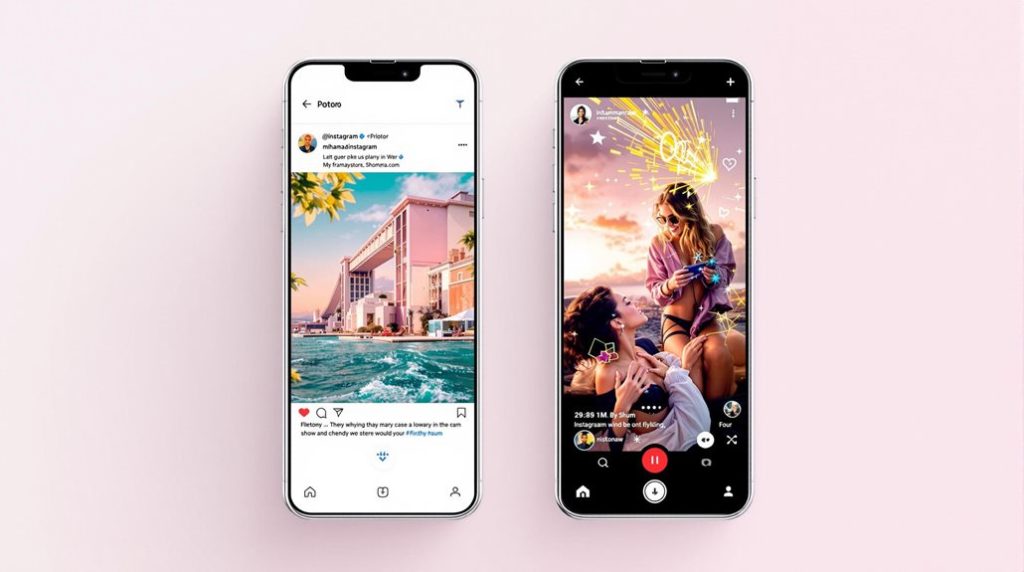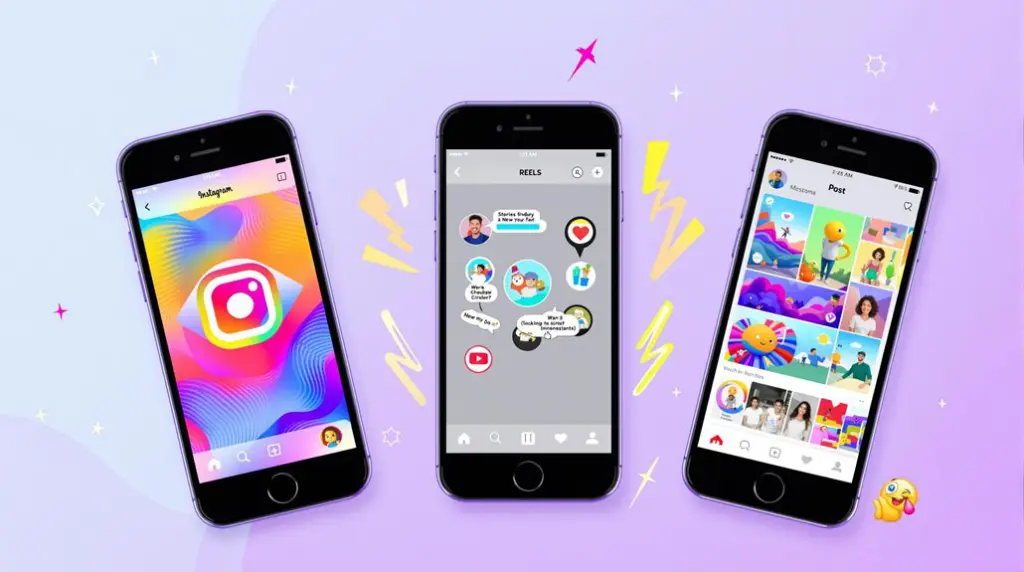Choosing between a Creator and a Business Instagram account requires understanding their core differences. Creator accounts focus on personal branding and community interaction, offering flexible profile categories and privacy options for contact information. In contrast, Business accounts are tailored for brands, featuring public contact details, advanced scheduling, and e-commerce integration. Both accounts provide analytics, but Business accounts prioritize conversion metrics and sales insights, while Creators focus on engagement like likes and comments. Shifting between accounts is smooth, with historical data preserved, allowing flexibility as needs evolve. Explore further to grasp the nuances and strategic advantages each offers.
Key Takeaways
- Creator accounts focus on personal branding, while Business accounts prioritize customer interaction and sales.
- Business accounts have extensive contact information, whereas Creator accounts can limit contact info for privacy.
- Advanced scheduling tools are available to Business accounts, enhancing content management efficiency.
- Creator accounts emphasize engagement metrics like likes and comments, while Business accounts focus on conversion and sales analytics.
- Profile categories differ: Creator accounts use categories like "artist," while Business accounts use categories like "retail."
Overview of Account Types
Instagram provides users with three distinct account types—Personal, Creator, and Business—each catering to specific user objectives and needs. Among these, the Creator vs Business account distinction is particularly significant.
Creator accounts are tailored for influencers and content creators focusing on personal branding and community engagement, offering unique features such as detailed insights into audience demographics and content performance. This account type allows for greater privacy by enabling users to hide contact information, which is ideal for those prioritizing personal brand consistency and community building.
In contrast, Business Accounts provide a more robust platform for brands and organizations aiming to promote and grow their products or services. These accounts offer customizable call-to-action buttons and public profile categories, enhancing engagement and accessibility.
Additionally, the insights and analytics provided by Business accounts are more thorough, allowing users to track audience interaction and optimize marketing strategies effectively.
Both account types offer advanced insights and analytics, but the key difference lies in the flexibility of contact options and the public nature of Business profile categories. Users can seamlessly switch between these account types to best meet their evolving needs, ensuring that Instagram remains a versatile platform for diverse user objectives.
Beyond the distinct characteristics of Creator and Business accounts, both share several features designed to enhance user experience and engagement on the platform. A key shared feature is access to analytics and insights, which provide valuable data on content performance and audience demographics. This enables both Creator and Business accounts to develop data-driven content strategies, optimizing their reach and engagement.
Another notable shared feature is the two-tab inbox system, which allows users to efficiently manage direct messages through Primary and General tabs. This organization helps in maintaining streamlined communication, essential for managing interactions with followers and potential clients.
Additionally, both account types benefit from the Saved Replies feature, enabling quick responses to frequently asked questions, consequently enhancing user interaction efficiency.
In terms of monetization strategy, both accounts can employ Shoppable posts, allowing users to tag products directly in their content, facilitating smooth e-commerce integration. While specific functionalities may vary, this feature supports a seamless shopping experience for followers.
Furthermore, the Paid Partnership tag available to both account types promotes transparency in sponsored content collaborations.
Differentiating Factors
When comparing Creator and Business Instagram accounts, distinct differences emerge in profile categories, contact information display, and scheduling tool capabilities.
Creator accounts prioritize personal branding with flexible profile options and concealed contact details, while Business accounts maintain transparency with mandatory public contact information and a defined business category label.
Additionally, Business accounts benefit from advanced content scheduling through third-party tools, contrasting with the more limited scheduling options available to Creator accounts via Instagram's Creator Studio.
Profile Categories Comparison
Profile categories serve as distinguishing markers between creator and business Instagram accounts, each tailored to specific identification needs.
Creator accounts utilize profile categories such as "chef," "artist," or "influencer," which cater to personal branding and content creation. This allows creators to project an image that aligns with their individual style and the unique content they produce. These categories help in enhancing engagement levels by attracting an audience that resonates with the creator's personal narrative.
On the other hand, business accounts employ categories like "bakery," "agency," or "retail," which focus on brand identification and organizational representation. This account type is structured to meet commercial objectives, positioning the business in a manner that appeals to potential customers and clients. By choosing a business-oriented category, the account emphasizes its role in the commercial landscape, aiming to drive customer engagement through clear brand messaging.
The choice of profile category greatly influences how users perceive the account's purpose and target audience.
Both account types have the flexibility to hide specific profile information, yet the available categories and their implications demonstrate a clear divergence in the primary goals of creator versus business accounts.
Contact Information Display
In the domain of Instagram account differentiation, contact information display serves as a pivotal factor that delineates creator accounts from business accounts. Business accounts are equipped to provide extensive contact information, including phone numbers, email addresses, and even physical locations. This enhanced visibility facilitates customer engagement by allowing direct communication and inquiries.
Additionally, business accounts can integrate customizable Call-to-Action buttons, such as "Call," "Email," or "Directions," directly on their profiles, further streamlining the interaction process for potential customers.
In contrast, creator accounts offer a more limited display of contact information, typically restricted to an email address. This limitation underscores the emphasis on privacy for individual content creators who might prefer to engage with their audience on a more personal level without the exposure of additional contact details.
Creator accounts also allow users to hide their contact information and business category, focusing more on personal branding rather than traditional business representation. While business accounts prioritize visibility to enhance customer interactions, creator accounts place a premium on maintaining privacy and fostering personal engagement, ensuring that the account holder's personal branding remains at the forefront of their online presence.
Scheduling Tools Limitations
Beyond contact information display, the tools available for scheduling content mark another key difference between creator and business Instagram accounts.
Creator accounts face limitations with scheduling tools, mainly relying on Instagram's Creator Studio. While it offers essential content management features, it lacks the robust automated publishing capabilities that business accounts enjoy. This poses challenges for creators in efficiently managing their posting schedules, especially when coordinating with broader marketing campaigns.
In contrast, business accounts benefit from a wider array of third-party scheduling tools that allow automated publishing. This enhances the overall efficiency of content management, providing brands with the flexibility needed to plan and execute marketing campaigns more effectively.
The automated scheduling options available to business accounts enable a seamless alignment of content with promotional strategies, allowing for precise timing and consistency in brand messaging.
For creators considering the benefits of changing, switching to a business account can greatly improve scheduling capabilities. This alteration grants access to advanced scheduling tools that streamline content management and enhance operational efficiency.
Ultimately, the increased flexibility and automation available to business accounts make them a superior choice for those prioritizing strategic marketing execution and content alignment within Instagram's dynamic ecosystem.
Insights and Analytics
Revealing the potential of Instagram's Insights and Analytics is essential for both Creator and Business account users, as these tools offer an all-encompassing view of audience engagement and content performance. Accessed through the Professional dashboard, these insights provide invaluable data on audience demographics and engagement metrics, which are vital for understanding overall account performance.
Creator accounts emphasize metrics such as likes and comments, while Business accounts focus more on conversion metrics and sales performance. Both account types benefit from tracking follower counts and audience growth, enabling users to refine their content strategies effectively.
For Creator accounts, a unique advantage lies in monitoring daily follower and unfollower counts, offering a granular view of audience growth. This feature allows creators to tailor their content strategies by understanding which content resonates most with their audience.
Meanwhile, Business accounts utilize insights to optimize sales and conversion strategies, leveraging detailed analytics to drive business objectives.
Regular evaluation of insights for both account types is paramount to optimizing content strategies and enhancing audience engagement. By understanding specific content performance, impressions, and reach, users can make data-driven decisions to improve their presence and impact on the platform.
Account Transitioning
Finding the change between Creator and Business Instagram accounts is a seamless process, thanks to Instagram's user-friendly settings menu. Users can effortlessly switch between these two account types without the risk of data loss, guaranteeing that all historical insights and valuable performance metrics are retained.
This flexibility in account replacement is vital for adapting to evolving needs and optimizing engagement strategies.
When considering a change, users should regularly evaluate their account type suitability. Each account type offers unique tools and serves different purposes, making it essential to select the one that aligns with current goals.
Instagram provides a step-by-step guide within its settings to facilitate this process, guaranteeing a smooth experience.
To guarantee a successful change, users should:
- Analyze Performance Metrics: Retain essential data by switching between Creator and Business accounts, while reviewing insights to determine the best fit.
- Consider Unique Tools: Evaluate the specific features of each account type to maximize functionality.
- Avoid Data Loss: Be cautious when switching to a Personal account, as this results in the loss of all historical insights.
Choosing the Right Account
When selecting between a Creator or Business Instagram account, it is essential to assess your audience's needs and how they align with your brand's goals.
Evaluating growth potential involves understanding whether the features of each account type support your content strategy and audience engagement efforts.
Ensuring that your chosen account type matches your objectives can greatly impact both your reach and brand development.
Understanding Audience Needs
Choosing the right Instagram account type—Creator or Business—requires a keen understanding of your audience's needs and your overarching goals.
Creator accounts are perfect for influencers and content creators aiming to enhance personal branding and foster community engagement. They offer unique features such as audience insights and message filtering, which help in understanding engagement metrics and tailoring content strategies.
On the other hand, Business accounts are tailored for brands seeking to amplify customer interaction and drive sales. These accounts provide robust tools like conversion-focused data and customizable call-to-action buttons, essential for effective social media marketing.
To make an informed decision, consider the following:
- Audience Insights: Determine whether your focus is on building a personal connection (Creator) or driving sales through customer interaction (Business).
- Engagement Metrics: Evaluate which account type offers the analytics that align with your content strategy and growth objectives.
- Content Strategy: Regularly assess your audience's needs to guarantee the selected account type effectively supports your social media goals.
Ultimately, the choice between Creator and Business accounts should reflect both your audience's expectations and your strategic objectives, allowing for seamless adjustments to enhance engagement and achieve desired outcomes.
Evaluating Growth Potential
Evaluating growth potential is a vital step in selecting the appropriate Instagram account type for your objectives. Business and Creator accounts offer distinct advantages tailored to different growth strategies.
For brands and organizations, a Business account provides advanced analytics and insights, essential for refining content strategies and enhancing audience engagement. The integration of shoppable posts and call-to-action buttons further facilitates e-commerce growth, offering a seamless path from content to conversion.
On the other hand, Creator accounts are designed for individuals focusing on personal branding and community building. They offer unique monetization tools like subscriptions and badges, allowing creators to optimize income while maintaining robust audience engagement.
The insights available through Creator accounts help in understanding audience demographics, enabling personalized content strategies that nurture community growth.
Regular analysis of performance metrics, available in both account types, is critical for maximizing growth potential. This process helps in identifying successful strategies and areas for improvement.
While switching between account types is straightforward, it is essential to weigh the potential loss of historical insights when altering frequently. Ultimately, the choice between Business and Creator accounts should align with your specific growth objectives and content goals.
Aligning With Brand Goals
Selecting an Instagram account type—Creator or Business—should align with your brand's overarching goals to maximize effectiveness. The decision hinges on understanding the primary objectives of your brand.
Creator accounts are particularly beneficial for individuals focusing on personal branding and community engagement, such as influencers or artists. They provide tools for content monetization and audience interaction, fostering a loyal fanbase through features like subscriptions and badges.
Business accounts, on the other hand, are tailored for brands aiming to enhance sales and product visibility, equipped with advanced marketing tools and customizable Call-to-Action buttons to drive specific customer actions.
When choosing your account type, consider the following:
- Goals: Determine whether your priority is community engagement and personal brand building or driving sales and conversions.
- Tools: Evaluate the need for Business account features like Call-to-Action buttons versus Creator account monetization options.
- Metrics: Decide if your focus is on engagement metrics such as likes and comments or conversion metrics related to sales and website visits.
Regular assessment of your account is essential, as both Instagram account types offer analytics and insights, enabling adaptation to evolving brand goals without data loss.
Frequently Asked Questions
What Is the Difference Between Creator and Business Instagram Accounts?
Instagram account types differ primarily in features and tools: Creator accounts prioritize audience engagement, content strategy, and profile customization, while Business accounts focus on analytics tools, monetization options, follower insights, brand partnerships, and growth strategies.
What Happens if I Switch From Business to Creator on Instagram?
Switching from a Business to a Creator account on Instagram alters account functionality and analytics insights, impacting branding considerations. Creator tools enhance audience engagement strategies and content monetization options, while privacy settings and business outreach methods vary considerably.
What Is the Disadvantage of an Instagram Creator Account?
The disadvantage of an Instagram creator account includes content limitations, restricted analytics access, and fewer monetization options. Additionally, it offers limited audience engagement tools, follower growth strategies, profile customization, post scheduling, collaboration features, and promotional tools compared to business accounts.
Can You Tell if Someone Has a Business or Creator Account on Instagram?
To discern between a business and creator Instagram account, examine account features like profile customization, advertising options, and monetization strategies. Business accounts emphasize brand partnerships and sales, while creator accounts focus on content strategy and audience insights.
Conclusion
In examining the distinctions between creator and business Instagram accounts, it is evident that each serves distinct purposes tailored to different user needs. Shared features provide foundational tools for engagement, while differentiating factors cater to specific functionalities. Insights and analytics offer valuable data for content strategy, with account alteration facilitating adaptability. Selecting the appropriate account type hinges on aligning user objectives with the available features, ensuring effective utilization of the platform's capabilities for personal or commercial success.




